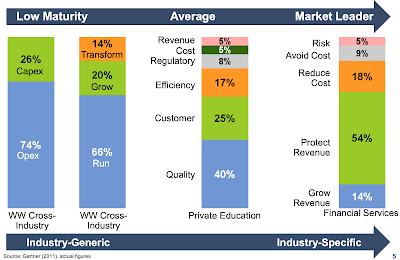
28 Jan Show Me Your Budget and I’II Tell What You Value

Being in the middle of the yearly budgeting process I could not help but think about this quote from former US Vice President Joe Biden.
“Don’t tell me what you value, show me your budget, and I’ll tell you what you value.”
The RGB model developed in the early 2000s by Louis Boyle at Meta Group, and in increasing use by companies like Gartner and McKinsey, can help you with both seeing and showing what you value.
It offers a business-oriented way to categorize technology investments at a high level.
The model classifies investments as having one of three purposes: to Run, Grow, or Transform the business. Hence RGB model. Each classification implies different kinds of benefits.
“Run the Business” Investments
“Run the business” investments are about enabling essential, non-differentiated services having the desired balance between cost and quality. Benefits are measured in reduced cost, price-to-performance ratios, and risk.
Examples of “run the business” functions for most businesses include audit, payroll, and regulatory compliance. On the technology side, examples include most infrastructure investments, most IT security spending, and most IT operations spending.
“Run the business” investments do not produce revenue. They are essential to staying in business, but they don’t differentiate the business in most cases.
Exceptions include those cases wherein customers begin to perceive a “run the business” function as a differentiator, as appears to be happening now with “green” (environmental) initiatives and has happened recently with IT security in the financial and cloud services industries.
Many CIOs struggle to justify infrastructure investments, but in “run the business” terms the case is usually straightforward.
First, the function is essential and typically does not need justification per se (e.g., the organization is going to be compliant with Sarbanes-Oxley in one way or another), although the level of performance required may vary (how compliant must we be?).
Second, the proposed investment will deliver the best possible price for the required level of performance (e.g., it costs much less to upgrade systems over five years than to hire an army of expensive auditors annually). Price-to-performance benefits such as these are often easily and accurately calculated.
“Grow the Business” Investments
“Grow the business” investments are about improvements in operations and performance related to the company’s existing markets and customer segments.
The value of such investments may be measured in terms of operational performance improvements, such as cycle time or improved quality, or in financial terms, such as capital expense reduction, increased revenues and margins, increased customer lifetime value, or reduced general and administrative expenses.
Examples include opening a new online or social networking channel for sales and service of existing product lines, or eliminating 10 percent from costs of conducting a key business transaction.
When you’re talking about improved profits or service to customers, in most cases you’re talking about growing the business.
“Transform the Business” Investments
“Transform the business” investments are about new markets, new products, new customers—in other words, new horizons for the company, and maybe for the entire industry.
Such investments are measured in prospective market share and revenues in entirely new markets. These investments typically involve big rewards and high risk.
They can change the future of the company and even an industry when they succeed, or produce a large hole in the ground when they fail.
Apple changed its own course and that of the music industry with iTunes; Motorola lost billions of dollars and an untold amount of alternative opportunities when the Iridium project failed.
The word transform is often used in businesses to describe a lot of initiatives that would be classified as “grow the business” projects.
In this classification scheme, by definition transformative initiatives involve new markets, new customer segments, and new value propositions, and not merely improved margins or profits.
For example, a supply chain “transformation” that produces 40 percent increased throughput at a 30 percent reduction in costs with 20 percent improvement in quality is a “grow the business” initiative and not a transformation.

Focus on Economic Benefits of Investments
Many projects and initiatives have objectives like “delighting the customer,” “improving time to market,” “happy employees,” or “operational efficiency.”
But hardly any organization will be blessed with unlimited resources to invest, and there’s just no getting around the fundamental challenge that all organizations face: sustaining themselves.
At some point the projects and initiatives you invest your limited resources in should help the organization to sustain itself and possibly even grow. So the question becomes “How do these benefits impact the economics of your organization?”.
The risk of placing too much focus on the economic benefits is relatively small and one can argue that lately it’s largely been ignored by many organizations (just have a look at the number of Silicon Valley unicorns that are currently imploding). It is of no help having happy customers and no revenue.
The biggest risk of focusing on the economic benefits of projects is when organizations find opportunities to reduce costs that may ultimately have a negative impact on the customer experience. This is particularly problematic for service organizations, where a more efficient operation often translates to less happy customers.
To make estimating the benefits of a project easier and more realistic, I use a simple model to assess the economic benefits of a project.
It consists of five benefit types (or buckets).
1) Increased Revenue
2) Protected Revenue
3) Reduced Costs
4) Avoided Costs
5) Positive Impacts
Run, grow, and transform are not benefits; they simply point to the types of performance improvement that should be expected from an initiative and thus show you where to look for the benefits.
If you say, “This is a “grow the business” initiative,” it is still necessary to say exactly how the initiative will grow the business.
> Will it increase margins for a key line of business? If so, how—by reducing costs, or by increasing revenues faster than costs?
> Will it increase market share? If so, in which customer segments, in which markets, by how much?
> Will it affect soft measures of value, such as customer satisfaction, that ultimately may translate to customer retention and so to revenue? If so, how will the value be measured?
Or as Gartner states it: “Market leaders track IT spending against strategic planning pillars”.

Technology Budget Conversations
Taking the above into consideration your IT budget conversations should have three dimensions:
1) Investments in IT needed to maintain products or services (Run). The benefits we can expect are reduced costs, avoided costs, protected revenue, as well as some other positive impacts;
2) Investments in IT capacity needed to support organic business growth (Grow). The benefits we can expect are increased revenue and reduced costs, as well as some other positive impacts;
3) Investments in IT needed to support new products or services (Transform). The benefits we can expect are increased revenue and reduced costs, as well as some other positive impact;
Don’t forget that part of 2) are tools to make your IT organization itself more productive. In a company whose IT-related costs are 25 percent of the overall budget, improvements in IT productivity have a direct impact on IT costs per business transaction.
A classic problem this model brings often to the surface is the disproportionate focus on Run as many CIOs spend more time in running the legacy systems and tend to allocate up to 60% (if not more) of the annual budget to this category due to small business demands and other legacy reasons.
Grow and Transform are not given enough importance thus constraining the ability of the organization to be ‘future-ready’ and competitive.
In a nutshell: Run, grow, and transform point to the types of performance improvement that should be expected from an initiative and thus show you where to look for the benefits.
Author Henrico Dolfing 3rd May 2020
https://www.henricodolfing.com/2020/05/your-budget-shows-what-you-value.html
